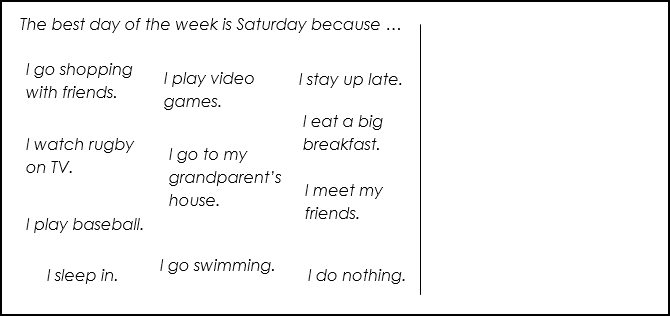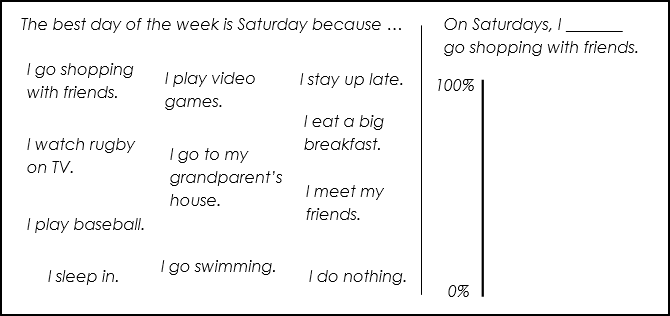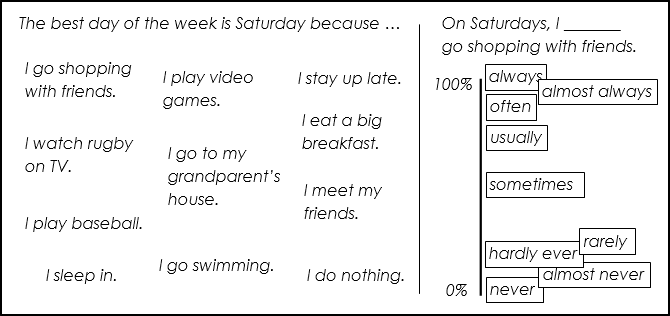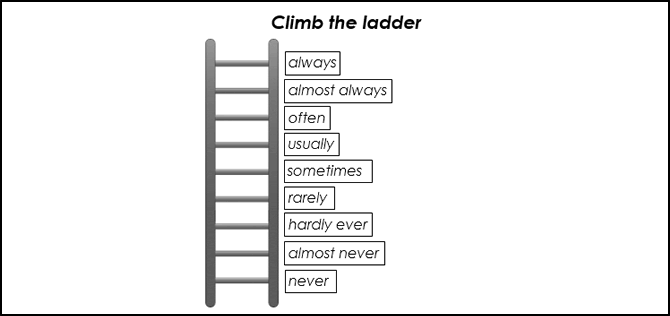Never Say Never Again Kids Song
What are adverbs of frequency?
Adverbs of frequency are used to say how often we do things or how often things happen. Hither are some common adverbs of frequency (in lodge from most frequent to least frequent):
- e'er (exercise 100% of the time - e.one thousand. She always drinks coffee in the morn.)
- almost always / nearly always
- oftentimes
- usually / frequently
- sometimes (do approximatley xl%-lx% of the time - eastward.g. I sometimes go for a walk in the evening.)
- occasionally
- rarely / seldom
- hardly ever / nigh never
- never (do 0% of the fourth dimension - e.g. He never passes his English test.)
Adverb position
An adverb of frequency goes earlier a primary verb in a sentence:
- I often play tennis on Sundays. (subject + adverb + main verb)
Nevertheless, the exception is when the sentence contains the verb 'to be'. In this case information technology goes afterwards the verb:
- I am usually hungry after schoolhouse. (bailiwick + to be + adverb)
In improver, when there is an auxiliary verb (e.g. have, will, must, might, could, would, can, etc.), the adverb is placed between the auxiliary verb and the principal verb.
- She tin can almost ever beat her brother at chess. (field of study + auxiliary + adverb + main verb)
These adverbs of freqnecy can also exist used at the starting time of a sentence:
Unremarkably, normally, ofttimes, often, sometimes, occasionally
- Sometimes, I get shopping on Sundays.(adverb + discipline + main verb)
Notes:
In this lesson students volition practice saying adverbs of frequency to indicate how often they do certain activities. It is an action-packed lesson with lots of fun action activities.
Of import: This lesson reviews vocabulary and structures from the Days of the Week lesson, so exist sure to take taught information technology earlier this one.
Lesson Process:
Warm Up and Maintenance:
See our "Warm Up & Wrap Upward" page.
New Learning and Practice:
1. Review days of the week and play ball toss
To begin, get everybody standing up and toss a ball to a student who tosses it to another student and and so on around the class – let everyone have fun for a minute throwing the ball effectually the form and trying non to let information technology drop on the floor.
Next, take a student toss the ball to you lot and as you catch information technology shout "Monday". Toss the ball to some other student and encourage him/her to shout "Tuesday" as they catch it. Go along with the days of the week being shouted out in the correct order, going around the course. If the ball is dropped or the incorrect solar day is said you must start over again with Mon. Set a target of three or 4 fast rounds without mistakes or dropping the ball.
ii. Discuss the all-time day of the calendar week
Get everyone to sit downwards. Write on the top of the lath "The all-time day of the week is" and ask the grade for their answers. Most probably information technology will be Sat or Sunday. Have a vote for the most popular answer and write this on the board, for example:
The best day of the week is Saturday
Next, ask why it is the all-time day of the week and encourage students to shout out answers. Write the things they do on the lath as they are shouted out, for example:

three. Introduce the adverbs of frequency
Cull ane of the activities on the board, such as "I go shopping with friends". In the space on the right-side of the board write "On Saturdays, I _________ go shopping with friends".
And then under this, draw a vertical line with 0% at the bottom and 100% at the superlative to make a frequency chart, as follows:

And so point to yourself and signal at the 0% and shake your caput to indicate that you never become shopping with friends on Saturdays.
Side by side, get a few volunteers to come up to the board and betoken on the vertical line where their answer would be (east.yard. around fifty% for sometimes, 70% for often, etc.).
At this indicate we'll add the frequency adverbs to the chart. Earlier class, fix cards with the adverbs of frequency written on them (e'er, almost ever, often, commonly, sometimes, rarely, hardly always, almost never, never). Put the "never" card at 0% on the lath. Say "I never go shopping with friends on Saturdays".
Give the residue of the cards to dissimilar students and ask them, one-by-one, to come to the board and place them where they retrieve they would keep the chart. As each student guesses, get everyone to help by maxim "higher!" or "lower!". Go along having students come upwards to the board with their cards until y'all accept a completed chart:

Go around the course request everyone to say how often the go shopping using the full structure (due east.grand. "On Saturdays, I frequently get shopping with friends.")
Put students into small groups of 3 or 4 and go them to say how oft they practise all the activities written on the board. Circulate and assistance out with mistakes.
Finish by asking a few students some questions, for instance,
Teacher: Frank, how often exercise you go swimming on Saturdays?
Student: On Saturdays, I hardly always become swimming.
Teacher: Good job! Helen, how often practise yous sleep in on Saturdays?
Student: On Saturdays, I always slumber in.
etc.
4. Do the "Adverbs of frequency questionnaire"
Put students in pairs. Requite out the A/B pair worksheets and allow a couple of minutes for everyone to check for vocabulary issues. Then get-go the action - anybody asks their partners the questions from the questionnaire and records their answers. At the end, have your students tell the class about their partners.
5. Play the "Climb the frequency ladder" game
On the lath write the championship "Climb the ladder" and draw a ladder with nine rungs, running from the top of the board to the bottom.
Label each rung with the adverbs of frequency from today's lesson, with "never" on the bottom rung and "e'er" on the height, for case:

Become everyone to stand up upwardly and find a partner. Tell the grade that anybody starts on the bottom rung of the ladder and to win they must attain the top rung. They practise this by asking their partner questions, trying to elicit the response for the rung of the ladder they are on. For example, for the bottom rung, they must get their partner to answer "never":
Student A: How often practice you cook dinner?
Student B: I never cook dinner.
If the answer is "never" the student moves up to the next rung ("most never"), changes partners and asks questions to arm-twist the next adverb. However, if the answer is wrong, they get knocked downward a rung of the ladder. They are allowed to ask questions to the same partner if they are knocked back down, but one time they get to a higher rung they must change partners over again. The student who gets to the meridian of the ladder outset is the winner.
half dozen. Read classroom reader "The Mystery of the Missing Magic Carpet"
Let's terminate the lesson with a fun story! Before class, download and print off the reader "The Mystery of the Missing Magic Carpeting". As you get through each page, bespeak to the pictures and elicit what everyone thinks is happening, for example:
 Teacher: (pointing at the motion picture on page three) Oh dear, Maria doesn't look very happy, does she? What do y'all recall is incorrect?
Teacher: (pointing at the motion picture on page three) Oh dear, Maria doesn't look very happy, does she? What do y'all recall is incorrect?
Educatee: Her pencil is on the floor?
Instructor: Yeah, it is on the flooring. But why is Maria unhappy?
Student: Did you lose her pencil?
Teacher: Mayhap! Let's check (reading … ) "This was foreign. I inappreciably ever lose things. Last year, I lost a pencil only that is the but thing I have always lost." Yeah, you lot are right! Well done!
etc.
Get the students really involved in the story by request lots of questions and getting them to speculate about the story and using adverbs of frequency.
After reading the story, requite out a reader worksheet to each student and accept everyone effort to remember which adverb is used in which part of the story and fill in the answers on the worksheets. And then become quickly go through the story once again, checking the answers.
---
Alternatively, watch our video version of the reader (Internet connection required):
Wrap Upwardly:
i. Assign Homework: "Adverbs of frequency write" worksheet.
two. Wrap up the lesson with some ideas from our "Warm Up & Wrap Up" page.
manifoldwhateening01.blogspot.com
Source: https://www.eslkidstuff.com/lesson-plans/adverbs-of-frequency.html
0 Response to "Never Say Never Again Kids Song"
Post a Comment